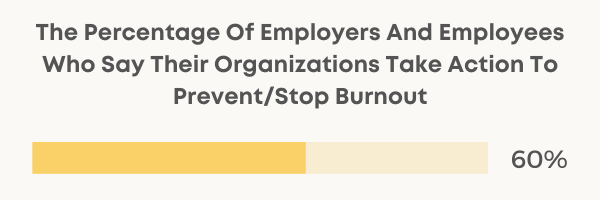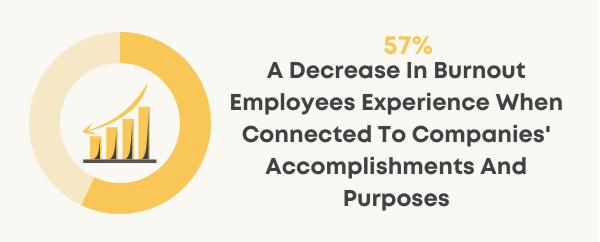Burnout is one of the most talked-about topics this year and leaders are experiencing it along with workers.
How can leadership burnout statistics serve organizations?
Well, they can help them and warn them about the seriousness of the situation. Meanwhile, it can also aid them in realizing that burnout could affect their results and their ability to compete and succeed.
Let’s dig into these statistics and see what is going on!
Leadership Burnout Statistics
(Editor’s Pick)
- Almost 60% of leaders feel used up at the end of their day.
- 86% of high-potential employees are at risk of burnout.
- 70% of workers say leaders are not doing enough to treat burnout.
- Due to burnout, 67% of leaders are less productive.
15 Leadership Burnout Statistics
1. Almost six in 10 leaders report feeling used up by the end of their working day.
Concerning statistics about leadership burnout tell us that around 60% of leaders feel used up at the end of their working day. According to DDI and their Global leadership Forecast 2021, this is a strong indicator that leaders are experiencing burnout.
Source: DDI
2. About 44% of leaders who report feeling used up expected to change companies to progress.
While many leaders said they felt used up at the end of their day, 44% of those also wanted to change companies in order to advance. Moreover, 26% expected to leave their jobs within one year.
Source: DDI
3. Around 60% of employers and employees say their companies take initiative to stop or prevent workplace burnout.
On one hand, 59% say their companies are doing something to prevent or stop workplace burnout. Yet, 29% say they wish companies would show more empathy when it comes to burnout. Burnout is a concern for both in-house and remote workers at 43%. This is according to Ultimate Kronos Group data, who surveyed 3,900 employees and business leaders in 11 different nations.


Source: Ultimate Kronos Group
4. Around 20% of employees are at risk of burnout because of low leadership and employee engagement.
According to a study by Gallup, 20% of employees are at high risk of burnout connected to low employee and leadership engagement. That is to say, leaders have a large impact on burnout in employees. However, even employees with high levels of engagement can be at a high risk of burnout.
Source: Gallup
5. A 57% decrease in employee burnout happens when leaders help them feel connected to companies’ purpose, accomplishments, and their colleagues.
A significant decrease in employee burnout of 57% is detected in relation to leaders. Namely, when leaders help their employees feel connected to companies’ accomplishments and purposes. Moreover, it also helps if employees feel a connection with their colleagues.
Source: O.C. Tanner


6. Around 86% of high-potential employees are feeling exhausted.
A large majority of employees (86%) who have a high potential for leadership are feeling exhausted, according to leadership burnout statistics data. In comparison to 2020, this is a 27% increase in high-potential employees who feel exhausted.
Source: DDI
7. Burnout costs US healthcare $190 billion a year.
Every year, according to the Harvard Business Review calculations, US healthcare spends between $125 and $190 billion on burnout. Moreover, burnout employees often feel disengaged at work, too. Additionally, Gallup calculated that disengaged employees due to burnout cost $3,400 out of every $10,000 in salary.
Source: The Harvard Business Review
8. Burnout employees and leaders have a 63% higher chance to take more sick days off work.
Burnout makes both employees and leaders exhausted, resulting in symptoms bad for their physical and mental health. While employees and leaders who experience burnout have a 63% higher chance to take more sick days off, they are also 13% less confident in their work.
Source: Gallup
9. Nearly 70% of workers believe leaders are not doing enough to treat workplace burnout.
According to Deloitte, almost 70% of professionals believe their leaders are not doing enough to help stop or prevent burnout within the organization. Moreover, 21% of professionals also say their employers do not offer any programs or initiatives that could help stop burnout.
Source: Deloitte


10. Only one in four leaders feels their employees are thriving mentally and emotionally.
According to Leadership IQ, only 25% of leaders believe their employees are thriving emotionally, as well as mentally. Moreover, 71% of leaders believe their highest-performing employees are to quit because of the issue of feeling burnt out.
Source: Leadership IQ
11. 79% of leaders report lower productivity levels in the workplace due to burnout.
According to the study by Leadership IQ, there is a burnout crisis going on for companies. For instance, 79% of leaders confirmed that their staff is less productive as a result of burnout. And around three in four leaders say their employees are making mistakes as a result of burnout.
Source: Leadership IQ
12. More than eight in 10 leaders (84%) admit hearing their employees use language suggesting job burnout and fatigue.
The most common words people use to suggest they are burnt out are “exhausted, sick, frustrated, tired, and burned”, according to the Leadership IQ survey.
Source: Leadership IQ
13. Nearly seven in 10 leaders (67%) are less productive because of burnout.
As a result of feeling burnt out themselves, 67% of leaders report lower productivity levels. Moreover, it is much harder for leaders to manage their employees and their burnout when they are burnt out as well.
Source: Leadership IQ


14. 24% of leaders say their companies run training to help employees successfully manage burnout.
The devastating share of only 24% of companies that are operating training to help employees manage burnout is not enough. Burnout will affect companies and that is why they need to find a way to stop it from happening.
Source: Leadership IQ
15. Employees say they experience burnout as a result of a lack of support and/or recognition from leadership.
Leadership plays a vital role in employees’ burnout. Employees report that the top driver of burnout for them is the fact they are lacking support and recognition from leadership.
Source: Deloitte
Final Verdict
To conclude, both employees and leaders are experiencing burnout, according to leadership burnout statistics. However, leaders have action to take to ensure that companies are successful. Moreover, leadership statistics and statistics on leadership in the workplace can help leaders and organizations find out which steps to take to get their leadership to a better level.


































Find Us on Socials